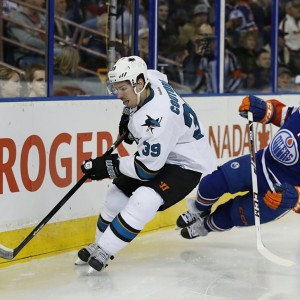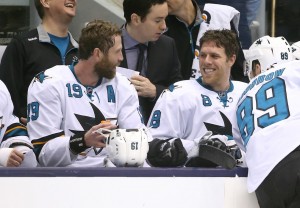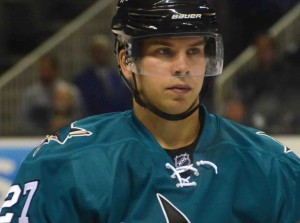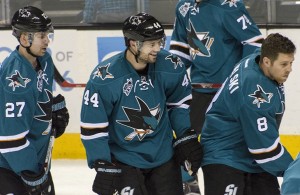The upcoming Western Conference Final features the St. Louis Blues and San Jose Sharks. For Blues fans wanting to know more about their current opponent, I thought I’d offer some help.

The Sharks are a roll ‘four lines and three defense pairs’ team. You’ll see everyone who skates a good bit. The team loves the forecheck and allows defensemen to be aggressive in the offensive zone. The Sharks are not overly physical, but they can handle a heavy game. The Sharks struggled the first half of the season but have been one of the league’s better teams since early January. That was when a comfort level with head coach Peter DeBoer’s system took hold, Logan Couture returned from injury and Brent Burns, the most interesting player in hockey, figured out how to play defense. The Sharks added three players at the trade deadline, all from Toronto. Two will play for certain, Nick Spaling and Roman Polak. James Reimer, the backup goalie, will only see action if needed.
In the playoffs, the only successful line against the Sharks came from Nashville. James Neal, Colin Wilson, and Mike Fisher combined for 19 points and were plus-6. The Sharks kept the Predators top forward, Ryan Johansen, in check. Three key Predators, Filip Forsberg, Shea Weber and Roman Josi were a combined minus-19. Against the Kings, Drew Doughty, Tyler Toffoli, Jeff Carter and Milan Lucic were a combined minus-17.
Forward Lines

The top forward line features Joe Thornton (jersey number 19), Joe Pavelski (8) and Tomas Hertl (48). Thornton had a Hart Trophy-worthy regular season (if the voters actually watched Sharks games, he’d easily skate away with it). He is an elite set-up man who plays effectively in every zone. Joe Pavelski has a terrific all-around game, but with a great set-up guy, he’s a goal scorer. His nine goals are tied for the most in the postseason. You’ll see him near the crease, battling defensemen. He gets knocked down a bunch, but it doesn’t slow him down. Tomas Hertl is a big body and he’s blended well with the two stars. In the regular season, these three players were a combined plus-66. In the playoffs, they are a combined plus-8. In the face-off circle, they are at 50%.
The second line came together late in their series against Nashville. Couture (39) leads the playoffs in points with 17. He has often struggled to find chemistry with Patrick Marleau (12), who returned to the second line wing a few games ago. The guy who makes this line work is rookie Joonas Donskoi (27), perhaps the Sharks most creative player. Even from the wing, he sets up other players, the perfect complement to the snipers on his line. You’ll notice him in a hurry. Not bad on the defensive side of things, either. Couture and Marleau, both lefties, have taken over 200 face-offs in the playoffs but are barely above 40% combined. Marleau is averaging over two minutes a game less in ice time than he did for most of the regular season (nearly three if you exclude the triple overtime game). He looks faster and fresher for it.

The Sharks third line includes Chris Tierney (50), who resembles Donskoi; both are creative set-up men. Tierney is challenged to compete physically, but he doesn’t need much time or space to generate scoring chances. One winger is veteran Joel Ward (42), physically strong with a well-deserved reputation for scoring critical goals. He is another blue paint player, good at screening the goalie. Melker Karlsson (68) plays an aggressive game but has found the postseason challenging. He is smaller, but he’ll go to the net front and hunt for loose pucks. These players have seven goals, 14 points and are a combined plus-5. The left-handed Tierney and right-handed Ward will handle the face-off duties, both are around 45% in the playoffs.
The fourth line has been in flux, due to adjustments up the roster and the recent injury to Matt Nieto. It finished the Nashville series composed of Dainius Zubrus (9), Nick Spaling (16) and Tommy Wingels (57). Nearing the end of a productive career, Zubrus, was given a player tryout by the Blues early in the season. They passed. The Sharks took a similar shot, signed him and he has been a gem. He understands how to fit effectively in any situation. He is a bigger guy and not afraid to play physical. Spaling is defensively responsible and plays a pesky style. Wingels is a bit undersized for a player who led the team in hits during the regular season. Fourth lines are often ‘do no harm’ and this line gets it. The three players have combined for only one goal and just two points but are a combined plus-2.
On Defense

On defense, the top pair is Marc-Edouard Vlasic (44) and Justin Braun (61). Vlasic is elite, though some speculate he is less than 100% healthy. He’ll be out there against the Blues top line. Vlasic has eight points (all assists) and is a team best plus-7. Braun has been more problematic. He has been the guy who loses his coverage a bit too often in his own zone. He has three assists and is plus-1.
The Sharks other top defensive pair is Burns (88) and Paul Martin (7). Burns has transformed his game from chaotic to well, a lot less chaotic. And way more effective. He’ll be the best athlete on the ice. The Norris finalist covers ground like no one else. His wrist shot from the point is the best in the game. He has 15 points and is plus-3. You’ll notice Burns, probably to the point you won’t notice Martin. Martin is effective, making the basic plays with ease. He sees the game extremely well; bad things tend not to happen in his vicinity. He has three assists and is plus-6.

The third defense pair is where the Sharks are most vulnerable. San Jose made an interesting move to pair a couple of bigger, slower defensemen together when they traded for Roman Polak (46) and paired him with Brenden Dillon (4). Polak played eight seasons for St. Louis, so Blues fans know him well. He is physically tough and if punches get thrown, he’s the Sharks player you’d want to be involved. His ability to cleanly exit the defensive zone has been an issue. Brenden Dillon had a solid season for the Sharks but was more effective with mobile partners like Matt Tennyson and Dylan DeMelo. Polak and Dillon are first and second in hits for the Sharks in the playoffs. Neither Polak or Dillon has scored in the postseason, they are a combined minus-4.
In Goal
The Sharks have used only one goalie in the playoffs, Martin Jones (31). His backup is the very capable James Reimer (34) who many thought outplayed Jones after being acquired late in the season. Jones is very quiet in the net, moves easily and is rarely out of position. He has shown some vulnerability high on his glove side; I’d expect that to be tested early and often. Jones, who backed up Jonathan Quick in Los Angeles prior to getting the starting job in San Jose, is playing under these bright lights for the first time. He’s shown no signs of letting the pressure get to him. His heavy workload might become an issue at some point.
Special Teams
The Sharks power play topped the NHL in goals scored during the regular season. It has gotten better in the playoffs, averaging over a goal per game. The Blues have one of the best penalty kills in the league, so it’ll be strength versus strength.
The Sharks penalty kill is an area of vulnerability. It has given up six goals in the postseason on 34 chances. Dainius Zubrus, Brenden Dillon, and Roman Polak all had excellent seasons on the penalty kill. Zubrus has yet to be on the ice for a goal against on the penalty kill.
The Sharks have outscored their opposition by 13 goals in the playoffs, the special teams’ differential is responsible for just over half of that. Another three goals in the differential come from 6-on-5 play with the opponent’s net empty. The even strength skating differential is just three.
Zeke’s Notes
The Sharks are healthy, the only missing player is Matt Nieto, a useful, but not critical role player.
The only former Shark still playing is Matt Carle of Tampa Bay. The second round saw the exit of the Caps’ Daniel Winnik, the Isles’ Thomas Griess and Steve Bernier plus the Stars’ Jason Demers and Antti Niemi.